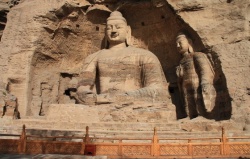T'ang Dynasty Esoteric School,buddha,China
China of the T'ang Dynasty (A.D. 618-907) was then the mostpowerful country in the world. It is the most glorious chapter in the history of the Chinese people and has lasting influence even to these modern days. There are “T'ang Ren Jie” (literally, T'ang People Street) or China towns everywhere in the world. When overseas Chinese return to China they still say “Go back to T'ang Shan” (literally, T'ang Country).
The T'ang Dynasty Esoteric School, an important school of Mahayana Buddhism, originated in India and was introduced to China by the three Mahasattvas – Subhakarasimha, Vajrabodhi and Amoghavajra in the Flourishing Kai Yuan Period (A.D. 713—741) of the T'ang Dynasty. In the history of this school, there were many eminent monks who were not only virtuous and talented but also patriotic and compassionate. They had great influences on politics and the economy and made outstanding contributions to the Chinese culture. Master Yi Xing was a patriarch in the T'ang Dynasty as well as a world-famous scientist with notable achievements in the scientific field of mathematics, astronomy, geography and calendar. Master Amoghavajra, a famous translator in the history of Buddhism, made significant contributions to the promotion of cultural exchange between China and India; and as National Master, he played an active role in suppressing rebellions and creating prosperous and stable economy for the country. The Japanese monk, Master Kukai, who had come to study in China received the Dharma lineage of the school from the Seventh Patriarch Hui Guo; on returning to Japan he spread the Chinese Culture. He became the First Patriarch of the Japanese Shingon School and was also a major founder of the Japanese culture.
The T'ang Dynasty Esoteric School ceased its propagation in China after the late T'ang Dynasty. It was only in the beginning of this century that the teachings were re-introduced back to China from Japan. The Fiftieth Patriarch, Maha Acarya Feng Da An worked on and perfected Dharma teachings passed down from the previous patriarchs; his works, influential both in China and other countries, would enable modern people to understand the T'ang Dynasty Esoteric School. His only Dharma Successor, Maha Acarya Yang Fo Xing, has also published enlightening articles.
This website will provide the oral teachings, written works and biographies of patriarchs of the T'ang Dynasty Esoteric School. These articles are unsurpassable Dharma treasures and will provide Buddhism practitioners the means to self-realization.
